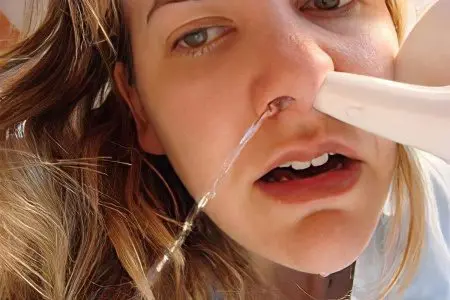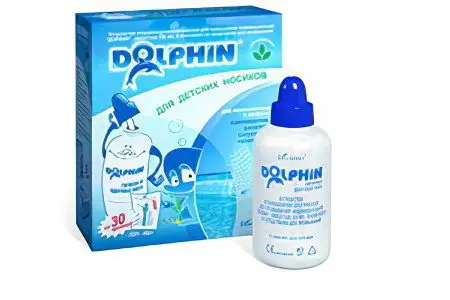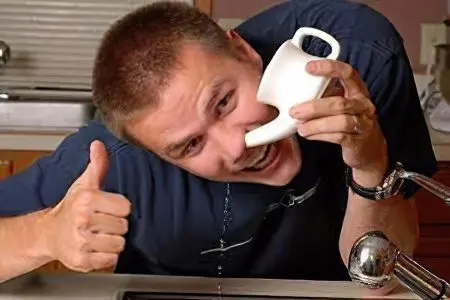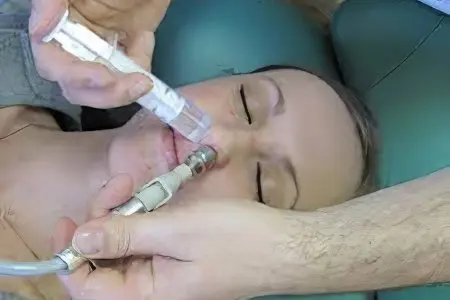Contents
Sinusitis is a disease in which there is an inflammatory process in the paranasal sinuses. Doctors use various methods of treating sinusitis, but each of them is assigned to wash the nose.
When carrying out these activities, drugs that have anti-inflammatory and antibacterial properties may be involved.
How to wash the nose with sinusitis?

If the first symptoms of sinusitis are detected, the patient should consult a doctor. After collecting an anamnesis of the disease, the specialist in most cases prescribes a nasal lavage. Thanks to this procedure, all purulent accumulations will be removed from the maxillary sinuses. Many patients who followed their doctor’s instructions exactly and regularly performed nasal irrigation at home were able to avoid painful punctures. The puncture of the maxillary sinuses is prescribed to patients in extreme cases, when none of the more gentle treatment methods brings the desired effect.
Currently, many medical institutions, including polyclinics, are equipped with physiotherapy rooms, in which patients diagnosed with sinusitis undergo nasal lavage. If the patient does not have free time to visit a medical institution, he can independently, at home, carry out the washing procedure. To do this, you need to purchase certain drugs that are highly effective.
The Scientific and Clinical Center for Otolaryngology of the Russian Federation, located on the territory of Moscow, conducted a series of studies in 2011, the main purpose of which was to compare existing methods for washing the nose with sinusitis. Highly qualified specialists also tested various medications, with the help of which they managed to achieve the most stable result for patients after the maxillary sinuses were freed from the accumulation of purulent masses.
The following medicines took part in this scientific experiment:
Aqua Maris;
Humer;
Aqualor soft.
In addition to identifying the most effective medical product, the following methods of nasal lavage were compared:
Dolphin;
according to Proetz.
For these experiments, Russian citizens were invited, whose age was in the range of 18-60 years. 150 participants were diagnosed with the same disease – chronic rhinitis. After all the experiments were carried out in the media, as well as on specialized Internet resources, the results were published.
Comparative studies of modern methods have shown the following:
the technique of washing the maxillary sinuses “Dolphin” took its well-deserved place of the leader. In 69% this method proved to be effective;
the method “according to Proetz” is slightly behind the leader. The effect of this method of washing the nose was obtained in 56%. At the same time, many patients, participants in the experiment, noted that small accumulations of purulent masses remained in the posterior parts of the nasal cavity. The specialists who supervised these scientific studies explain such results by the need for patients to take a horizontal position when washing.
When testing medicines, scientists have identified the following results:
Humer was effective in 43%;
Aqualor was able to show a result in only 41%;
Aqua Maris was able to provide assistance to patients in 18%.
As for the drug Aqua Maris, when using it, one should take into account its main focus: moisturizing the nasal mucosa. That is why the washing procedure, using this medication, turned out to be so ineffective.
When conducting research that dealt with nasal breathing, the following results were obtained:
the method “according to Proetz” – the patients who participated in the experiment began to breathe through the nose with virtually no symptoms of chronic rhinitis;
the method “Dolphin” in 96% proved its effectiveness. Patients showed clear improvements in nasal breathing.
This study also involved medications that could not show the expected effect:
Humer – 69%;
Aqualor soft – 62%;
Aqua Maris – 55%.
Studies, the purpose of which was to determine the nature of the fluid obtained (after the nasal lavage procedure), showed the following results:
the Dolphin method – turned out to be the most effective medical preparation that could remove 73% of mucus and crusts from the maxillary sinuses;
the method “according to Proetz” – in 66% proved to be effective;
the drug “Humer” – helped patients in 52%;
preparation “Aquamaris” – showed its properties in 50%;
the Aqualor Soft drug helped 43% of the subjects.
Scientists, after the end of all tests and experiments, made the following conclusion:
in the conditions of a medical institution, the method “according to Proetz” turned out to be the most effective;
at home, great results were achieved using the Dolphin technique.

Washing the nose with sinusitis “Dolphin”
“Dolphin” is a drug that contains mineral and plant components.
This drug has the following properties:
has antiseptic effect;
has bactericidal properties;
activates the production of mucus;
restores the mucous membrane of the nasal cavity;
normalizes the functioning of the epithelium (ciliated);
stimulates the production of antimicrobial substances;
increases local immunity and accordingly stimulates the protective properties of the body;
normalizes the water-salt balance in the nose, etc.
The drug “Dolphin” is usually prescribed for a period of 12 weeks. Patients need to wash their nose 2-3 times a day at home.
There are the following indications for the use of this drug:
trauma to the nasal cavity;
injury to the paranasal sinuses;
rhinitis (allergic, acute and chronic);
rhinitis that occurs during pregnancy;
sinusitis (acute and chronic);
sinusitis (acute and chronic);
frontal sinusitis (acute and chronic);
adenoids;
dry nose syndrome.
The drug “Dolphin” is sold in pharmacies in the form of a complex intended for washing the nose, which consists of:

from an elastic bottle (with a capacity of 240 ml);
special dispenser lid;
sachets containing the drug itself (30 pieces).
Using the recommendations given in the instructions for this medication, it is necessary to perform the following actions when washing the nose:
Dilute one sachet of Dolphin in boiled water (35-36 ° C).
Pour the resulting solution into an elastic bottle and tightly close the cap-dispenser.
Gently insert the dispenser into the nasal cavity and fix it against the walls of the nostril. This is to ensure that the drug does not leak out during administration.
When washing, the patient should bend over the tub or sink.
With a smooth but steady movement, it is necessary to begin the introduction of the solution into the nasal cavity. It is not necessary to inject the liquid too quickly, as it is possible to injure the mucous membrane.
After the introduction of half the solution into one nostril, the dispenser is removed and rearranged into the other nasal passage. The drug is also administered carefully and smoothly.
The final stage of washing the nose will include the following actions: squeeze the bottle tightly with your fingers and insert it into the nasal passage. After that, the fingers should be unclenched in order to completely remove the injected fluid from the sinuses with an admixture of pus and mucus.
Before using the drug “Dolphin” you need to consult your doctor for contraindications.
You should not use this medicine in the following cases:
children under 4 years of age;
the presence of a curvature of the nasal septum;
the presence of diseases: otitis media, tumors, allergies, nosebleeds, etc.;
with a blocked nose.
Washing the nose with sinusitis with furatsilin
Doctors often prescribe certain medications during the nose wash procedure. Most often, furatsilin is used, which is currently sold in any dosage form: solution, tablets, ointments, etc.
This drug has practically no side effects. It should not be used by people who have a tendency to:
allergic dermatitis;
bleeding;
hypersensitivity to the components of the drug.
In most cases, furatsilin is prescribed to patients who are diagnosed with sinusitis. The drug is used when washing the maxillary sinuses, from which it is possible to remove pus, mucus and crusts. Some experts recommend using drugs with antimicrobial properties in parallel with furacilin.
In order to properly carry out the procedure for washing the sinuses, patients need to act in a certain sequence:
Prepare a solution. This will require a container, boiled water (warm), in the amount of 1 liter, a douche and furacilin tablets. In warm water, you need to dissolve 1 tablet of this drug.
Fill the syringe with a solution of furatsilina.
Thoroughly clear the nose of mucus.
Lean over a bathtub or sink and turn your head so that the liquid, when injected into the sinus, cannot enter the middle ear.
It is necessary to inject the solution alternately, into each nostril. This should be done carefully so as not to injure the nasal mucosa. If the procedure is performed correctly, then the solution introduced into one nostril will pour out through the second.
After the end of the procedure, the patient should take a horizontal position. A pillow should be placed under the head to prevent fluid from entering the middle ear cavity.
Washing the nose with a solution of furatsilina must be performed 4 times a day for a week. Before each procedure, a fresh solution should be prepared, the remains of which should be poured after use.
How to rinse your nose?

In order to achieve the maximum effect during the nasal lavage procedure, while not injuring the mucous membrane, it is necessary to follow the recommendations of specialists exactly. The introduction of medications should be carried out only in the nasal cavities cleared of mucus, pus and crusts. Only in this case can one count on the full manifestation of the medicinal properties of the administered drugs.
When preparing a liquid for washing the nose, it is necessary to strictly observe all proportions in order to exclude irritation and burns of the mucous membrane from a too concentrated solution. Currently, experts prescribe various medications for washing, which have proven effective in the treatment of sinusitis.
This procedure can be performed in a physiotherapy room, or at home in the following cases:
after a puncture;
with partial patency of the nasal canals.
Before proceeding with self-washing the nose, you need to make sure that all instruments are sterile:
douches;
syringes;
small teapots;
sinus catheters;
nasal souls.
You should use only those medicines that are recommended by the attending physician – an otorhinolaryngologist. The procedure for washing the nose at home takes an average of 10-15 minutes. In the event that a patient diagnosed with sinusitis does not notice any improvement after several procedures, he should urgently contact his doctor.
1st method (the easiest) nasal lavage – flow

With this method, you can use a regular syringe. The preparation of the solution can be carried out both with the involvement of medicines and herbal preparations.
The patient must do the following:
lean over the sink or tub. After that, you need to turn your head to the side so that the less blocked nostril is one level higher;
it is desirable to start the procedure of washing the nose from the nostril that is the least stuffed;
the syringe tip must be inserted into one nostril smoothly and not deeply to exclude the possibility of mechanical damage to the mucosa;
liquid under a small pressure is introduced into the nasal sinus and flows out of the other nostril. During the introduction of fluid, the patient should make certain sounds, for example, a drawn out “and”;
after the procedure with one nostril, all actions should be repeated with the other nasal passage;
after washing, it is advisable to thoroughly blow your nose in order to eliminate the remnants of the solution, particles of mucus and pus from the maxillary sinuses.
After the procedure, it is better to stay at home for a while and not go out, as you can catch a bad cold. The patient is advised to lie down in bed and spend an hour in a horizontal position (a pillow should be placed under the head).
2nd method of washing the nose – “cuckoo”

This technique is used in medical institutions. Typically, such washing is prescribed for sinusitis, in parallel with drug therapy.
In the physiotherapy room, the patient is carefully drained of pus and mucus from the maxillary sinuses:
the specialist carefully introduces a special device called an aspirator-suction into one nostril of the patient;
as a result, negative pressure is created in the patient’s nasal cavity;
there is a circulation of fluid in the nasal passages in an accelerated rhythm;
while filling the sinuses with fluid, the patient should pronounce the word “ku-ku”.
During this procedure, the patient lies on the couch in the physiotherapy room. His head should be tilted back a little. Before washing, the patient is instilled into the sinuses with special solutions that have the property of constricting blood vessels. If the patient has a too advanced form of the disease, then during the washing, the opposite nostril should be clamped for a while. Due to this, the entire solution will evenly spread through the internal channels of the sinus.









